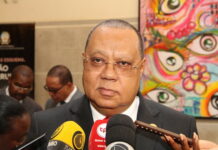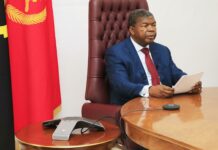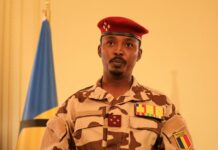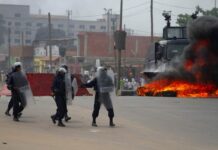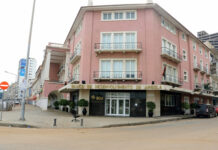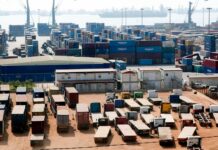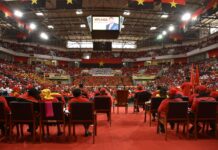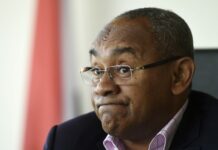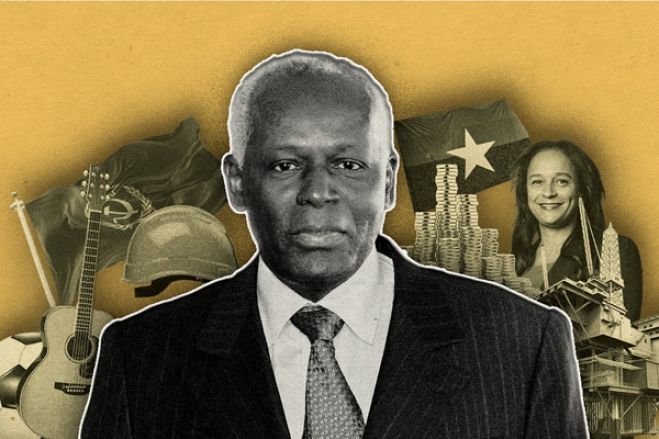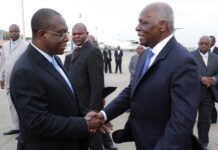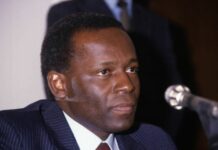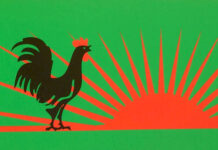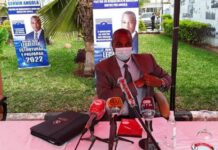Absolute silence reigns in the exclusive Miramar neighborhood, which was once the home of the colonial bourgeoisie of Luanda and is now home to embassies. A mansion hidden by giant yellow walls imposes itself with an enviable view of the Ocean. You don’t see anyone on the street.
Just two men under a tree, framed by the sea horizon. They are not just two men, the Observer perceives when they quickly approach and in abrupt ways they force to delete the photos that had just been taken. This is the residence of José Eduardo dos Santos since September 2017.
Swimming pools, gardens, basketball court, lavish rooms, everything seems uninhabited. Who lives here now? “We can’t say anything,” responded the guards, referring more steps to the back of the mansion where several security guards control access. The repeated question, documents scrutinized for long minutes and answer without retreat: “Only with an order from the Presidential Palace can we speak”. The “Casa Amarela” is an idle time: the former President of Angola has not lived here since April 2019.
Ten minutes by car, 14 kilometers and 77 years separated José Eduardo dos Santos from the frantic Sambizanga, the musseque where he is said to have been born. It is the distance between poverty and opulence, the time between the fragile son of a quintandeira and the almighty sovereign of Angola who, since this miniature of the pink presidential palace, watched, in surprise, as his power faded. from September 2017, in the onslaught against corruption launched by his successor, João Lourenço.
It was about eight hours into the flight, 8,500 kilometers and three years from his kingdom, taking refuge in another mansion, in the “elite district” in Barcelona, that saw the unthinkable happen: at the end of December 2019, a court order who seized the property of his daughter Isabel says that the former President of Angola authorized the diversion of more than 115 million from the public purse and illegitimately favored his daughter in the diamond trade. In January of this year, the Luanda Leaks scandal showed the world how Isabel dos Santos and her husband had allegedly used public funds for the benefit of their business empire.
Isabel dos Santos was a kind of lightning rod for an entire government and oligarchy loyal to the petrodollars. But the central figure in an institutionalized scheme of corruption is the father, José Eduardo dos Santos: it was he who, the master of almost absolute power for 38 years, made possible and legitimized an entire dubious system.
An episode that took place with the Observer in Luanda is symptomatic of how in his reign, acts outside the law gained normalcy.
With ten days and so many conversations to have, the days and nights were carefully organized to have time for everything. But nobody can predict some interviews. One of them was with the oldest official at the presidential palace who is still in service after starting to work in Cidade Alta during the times of Portuguese governors. The interview was long, including a religious hymn and a prayer proposed by Domingos Bandeira in his Sunday outfit just arrived from the Methodist church, and when the journalist left, it was after the agreed time with the driver. The protest was immediate:
– It was not this hour that suited me, lady.
Journalist apologizes, explains that they are unforeseen, etc. With his face closed in his thirties and dark glasses, Rayban did not soften and, with the greatest naturalness in the world, said:
– Because of you, I was unable to take a diamond package to the airport.
The conversation that followed showed that he was not playing.
“José Eduardo dos Santos, the father of the Luanda court”, is the first text of an extended work by Observer journalists on the Edwardian power network that gave rise to an unprecedented series of podcasts by the Observer. There are four texts:
– about the former President of Angola, published today ,
– about the daughter Isabel dos Santos, written by Filipe Fernandes, who will leave tomorrow,
– about son-in-law Sindika Dokolo (whose publication had to be brought forward due to the death of Isabel dos Santos’ husband in October, but which is released again on Wednesday), signed by Cátia Bruno,
– and about the dolphins Manuel Vicente and João Lourenço, by João de Almeida Dias, who will be able to read from Wednesday.
The podcasts, made by the executive editor of Rádio Observador, Ricardo Conceição, and with the sound design by Beatriz Martel Garcia, Dioga Casinha and Bernardo Almeida, are divided into four episodes:
– The traveler (who has been on Radio Observador today but who is always available on the website) and the Chief (who will be on tomorrow) dedicated to the former President of Angola
– Cara do Pai, which reveals how Isabel dos Santos was building her fortune, which passes on Wednesday, and O Mimoso, which shows how João Lourenço is a son of the system.
In the story about José Eduardo dos Santos, we followed his path since he was born, we heard the stories that show personality traits that led him to exercise an untouchable authority, to dominate the party, enemies and friends, the country. We spoke to over half a hundred people in Angola, Portugal, Brazil, the United Kingdom.
From ex-generals to academics, from ex-ministers to businessmen, from ex-guerrillas to activists, from a former prisoner in the Catete jail to a historian, who explained how José Eduardo dos Santos knew how to use (or force) the circumstances in your favor relentlessly.
We tell how he was a skilled Florentine politician, full of ambiguities (see the example of May 27, 1977) or how he came to receive an arrest warrant, but also how his personal and loving life was intertwined with his role as statesman.
From the first woman, Tatiana Kukanova, Isabel’s mother, who sold bottles of wine to buy a Renault 4, to the lover “Milucha”, mother of Tchizé and Corian Dú, who saw him with holes in his socks at Futungo de Belas, or at son who was raised for a long time by a friend. It has old photos and lots of sounds: even José Eduardo dos Santos singing for his then wife, Ana Paula dos Santos.
It’s just the beginning of the series. Don’t miss the rest.

